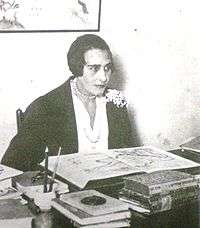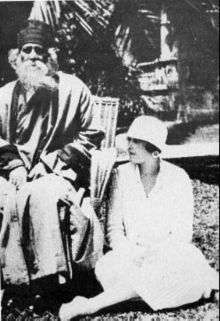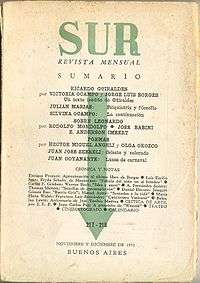Victoria Ocampo
| Victoria Ocampo CBE | |
|---|---|
|
Victoria Ocampo, 1931. | |
| Born |
Ramona Victoria Epifanía Rufina Ocampo April 7, 1890 Buenos Aires, Argentina |
| Died |
January 27, 1979 (aged 88) Béccar, Argentina |
| Nationality | Argentine |
| Alma mater | University of Paris |
| Occupation | writer and intellectual |



Victoria Ocampo CBE (April 7, 1890 – January 27, 1979) was an Argentine writer and intellectual, described by Jorge Luis Borges as La mujer más argentina ("The quintessential Argentine woman"). Best known as an advocate for others and as publisher of the legendary literary magazine Sur, she was also a writer and critic in her own right and one of the most prominent South American women of her time. Her sister, Silvina Ocampo, a writer also, was married to Adolfo Bioy Casares.
Biography

Born Ramona Victoria Epifanía Rufina Ocampo in Buenos Aires into a high-class society family, she was educated at home by a French governess. She would later write, "the alphabet-book in which I learned to read was French, as was the hand that taught me to draw those first letters."[1]
She is sometimes said to have attended the Sorbonne: on page 39 of her biography of Ocampo, Doris Meyer states that, during the family's 1906–1907 trip to Paris, the same during which she was etched by Paul César Helleu, the Ocampos allowed 17-year-old Victoria, "well-chaperoned", to audit some lectures at the Sorbonne and at the Collège de France. She remembered particularly enjoying Henri Bergson's lectures at the latter. She was not, of course, ever matriculated at either; her very old, traditional and rich family frowned on formal education for females, and so Victoria had none.
In 1912, Ocampo married Bernando de Estrada (aka Monaco Estrada). The marriage was not happy, and in 1920, the couple separated, and Ocampo began a 13-year affair with her husband's cousin Julián Martínez, a diplomat.[2]
In Buenos Aires, she was a lynchpin of the intellectual scene of the 1920s and 1930s. Her first book, written in French, was De Francesca à Beatrice (1923?), a commentary on Dante's Divine Comedy. Other works include Domingos en Hyde Park; El Hamlet de Laurence Olivier; Emily Brontë (Terra incógnita); a series called Testimonios (ten volumes); Virginia Woolf, Orlando y Cía; San Isidro; 338171 T.E. (Lawrence of Arabia) (a biography of T. E. Lawrence) and a posthumously published autobiography. There is also an edited book of dialogues between Ocampo and Borges.
Perhaps of greater significance than her own writing, she was founder (1931) and publisher of the magazine Sur, the most important literary magazine of its time in Latin America. Among the writers published in Sur were Jorge Luis Borges, Ernesto Sabato, Adolfo Bioy Casares, Julio Cortázar, José Ortega y Gasset, Manuel Peyrou, Albert Camus, Enrique Anderson Imbert, José Bianco, Santiago Davobe, Ezequiel Martínez Estrada, Pierre Drieu La Rochelle, Waldo Frank, Gabriela Mistral, Eduardo Mallea, Silvina Ocampo (her younger sister), Alfonso Reyes, and Enrique Pezzoni.
During the 1930s, Ocampo grew an ardent admirer of Benito Mussolini whom she met in person in March 1935 in Rome, hailing him then as "genius" and Caesar reborn.[3] "I have seen Italy in blossom turn its face towards him."[4] Only with the start of World War II, Ocampo became disenchanted with fascism. She supported and edited from Argentina in collaboration with her friend and translator Pelegrina Pastorino, the anti-Nazi magazine "Lettres Francaises" directed by Roger Caillois and in 1946 she was the only Argentinean who attended the Nuremberg Trials.
In 1953, Ocampo was briefly imprisoned for her open opposition to the regime of Juan Domingo Perón.
She was made a member of the Argentine Academy of Letters in 1976 (the first woman ever admitted to the Academy; she formally took her seat on June 23, 1977). The "cultural dialog", initiated in 1977 by the de facto government but organized by UNESCO, was held in her home, Villa Ocampo, in San Isidro, Buenos Aires Province; she eventually donated the house to UNESCO.
At "Villa Ocampo" Igor Stravinsky, André Malraux and Rabindranath Tagore had been her guests, also Indira Gandhi, José Ortega y Gasset, Antoine de Saint-Exupéry, Ernest Ansermet, Rafael Alberti, etc. Graham Greene dedicated his 1973 novel The Honorary Consul to her, "with love, and in memory of the many happy weeks I have passed at San Isidro and Mar del Plata" and in 1934 she was the recitant in the American premiere of André Gide-Igor Stravinsky's opera-ballet Perséphone at the Teatro Colón conducted by the composer.
Victoria Ocampo died in Buenos Aires in 1979, and is buried in La Recoleta Cemetery in Buenos Aires.
Honors
- Maria Moors Cabot prize
- Commander of the Order of the British Empire
- Doctor honoris causa – Harvard University, Columbia University
- Premio de Honor de la SADE
- Gold Medal – Académie française
Biopics
- Her life was portrayed in a film for TV in 1984 "Four Faces of Victoria", directed by Oscar Barney Finn with four actresses playing the different ages of Victoria (Carola Reyna, Nacha Guevara, Julia von Grolman and China Zorrilla).
- Her attitude and political views were depicted in Monica Ottino's theater play "Eva and Victoria", an imaginary confrontation between young Eva Perón and old Victoria. The play ran successfully during the eighties with Soledad Silveyra and China Zorrilla as Ocampo.
Notes
- ↑ Villa Ocampo: History
- ↑ Villa Ocampo
- ↑ Victoria Ocampo, 'Living History', in Against the Wind and the Tide, ed. Doris Meyer, University of Texas Press, Austin, TX, 1990, p. 217
- ↑ Victoria Ocampo, 'Living History', in Against the Wind and the Tide, ed. Doris Meyer, University of Texas Press, Austin, TX, 1990, p. 222
References
- Chiappini, Julio: Victoria Ocampo. Biografía, Rosario, Editorial Fas, 2012; 2 vol.
- Meyer, Doris: Victoria Ocampo: Against the Wind and the Tide (Texas Pan-American Series paperback, University of Texas Press Reprint edition, 1990) Originally published New York, George Brazillier, 1978. Re-issue ISBN 0-292-78710-3.
- Dyson, Ketaki Kushari: In Your Blossoming Flower Garden: Rabindranath Tagore and Victoria Ocampo New Delhi, Sahitya Akademi, 1988; reprinted 1996. ISBN 81-260-0174-7.
- Bassnett, Susan, 1990 (ed.): Knives and Angels: Women Writers in Latin America. London/New Jersey: Zed Books.
External links
- Victoria Ocampo's Project
- Victoria Ocampo's Chronology
- Ketaki Kushari Dyson, On the Trail of Rabindranath Tagore and Victoria Ocampo
